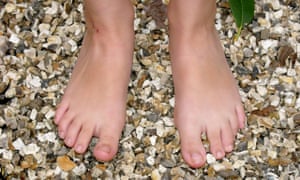There’s nothing more soul-sapping than a lengthy chat with a barefoot-running fundamentalist – as a new scientific study proves

I’m not averse to running: I run most days, for fitness and fresh air, and because it’s healthier than drugs for enhancing one’s mood. It’s sociable, too: I’ve made good friends through my local running club.
But certain social aspects of this pastime bore me to the brink of despair, and top of the tree of tedium is trash-talk about shoes. The dreariest variant spews forth from parishioners of the Church of Barefoot and Minimalist: people inexplicably possessed of a messianic fervour about the imagined merits of running in shoes that are, essentially, a bit less cushioned.
There is no respite from their jabbering on about which model is coolest, lightest, fastest; which provides most “real feel”, least sponginess, optimal “heel drop” … blah, blah, blah. It’s nearly enough to make me lob my knackered Nikes in the bin and acquire an immoderate drinking habit. Thankfully, I’m not the only one who has noticed this nonsense. A recent study from the British Journal of Health Psychology found that runners’ views on barefoot shoes are not only wildly inconsistent but also irrational – if not outright fantastical.
Whether or not barefoot or minimalist shoes offer performance advantages beyond their low weight (an obvious benefit), I don’t know. Nor do I particularly care. My a posteriori deduction, based on years of running and speaking to runners, is that those who run most, run fastest; those who train consistently and progressively suffer fewest injuries; shoe brand/make/model makes negligible difference.
To shoe bores, these common-sense observations are so unspinnable that it’s practically sacrilegious. There’s far more prattle mileage to be extracted from ideas that conform to our age’s defining dictum: thou shaltbuy more stuff. Being purists and tightwads, though, runners prefer their commodification disguised as anti-commodification, eg the oxymoronic “barefoot shoe”.
I’m going to ignore the limitations of the aforementioned study – for instance, the fact it involved interviews with just eight recreational runners – and instead focus on its unquestionably insightful “thematic analysis”. The aim of the research was to get a handle on how people perceive barefoot running, and it identified the dominant themes that follow:
Contents
‘Running in barefoot shoes is more natural’
It’s hard to argue with the observation that the human foot is a natural phenomenon whereas the Vibram FiveFingers Bikila Evo (£135), for example, is manmade. But the faith in barefoot running runs deeper: several of the participants commented that humans were designed to run without shoes. Assuming these individuals were not hardcore creationists, it really ought to have occurred to them that humans evolved brains big enough to let them develop a preference for wearing shoes that protect their feet from hard, pointy surfaces.
We run in sturdy-soled shoes on very reasonable grounds: unpredictable ground. I’ve been to Ethiopia and trained with hard-up runners for whom going without shoes would make very sound economic sense, but no, instead they scrape together the money to buy whatever tatty, old, secondhand trainers they can (just about) afford. And in those holey, heavy trainers, let me tell you, they run very fast indeed; faster than me, probably faster than you. Go figure.
‘Barefoot running is extreme’
Despite perceiving barefoot running as “more natural”, the interviewees also labelled it variously as “extreme”, “crazy” and “strange”. These views implicitly acknowledge – at last, some sense – that transcending our natural, bare-soled state by wearing shoes is manifestly expedient. Yet more reassuring was these individuals’ branding of barefoot running as a “cult” activity to be filed alongside other fads such the paleo and keto diets.
“I think that you build up an addiction,” said Anne, “a tolerance to certain activities. You have to start doing weirder and more extreme shit.”
Wise words, Anne. From barefoot running, it’s a slippery slope at the bottom of which one can only hope to emerge surrounded by padded things; soles, if not walls.
‘Running shoes should provide support’
Several of the participants in the study seemed heavily invested in the notion of support – but without any consensus among them on what the heck support means in a footwear context. One interviewee implied that barefoot shoes are supportive, whereas others deployed “supportive” as though synonymous with “well-cushioned”. There was lots of talk of support as a nebulous attribute that somehow keeps joints and limbs aligned and protected against injury.
Liz, for instance, favoured supportive shoes: “Yeah, just ’cause they offer support and they keep your ankle in place.” Where Liz’s ankles would have ended up without support, heaven knows.
Emma chipped in: “I wanted to make sure that my shoes support my feet, my legs, and my knees in particular.”
‘Shoe retailers are more trustworthy than scientists’
The study showed that, in establishing the criteria (eg “supportive”) for choosing shoes, the individuals questioned tended to trust online forums and running shop employees above medical specialists and academics. This is a somewhat bizarre choice of advice sources when you consider that quite a bit of rigorous research into barefoot running has been conducted, and subsequently rendered readable and interesting by erudite writers: most notably, this series of blogposts by the scientist Dr Ross Tucker.
Inexplicably, many seem to prefer to acquire their footwear wisdom through the prism of commercial interest; that is, from people whose livelihood depends on selling the latest and most gimmick-laden of the crop.
“I was lucky – they were honest with me,” said Paul of the running shop he visited. “They told me I should go to the more expensive shoe.”
Conclusion
The moral of this study is that some runners choose their footwear according to a haphazard mix of dubious determinants; they’re baffled by the huge array of choice, as well as by conflicting advice, bewitching marketing spiel and their own dazzled desires. They seek an impossible blend of the natural in the unnatural; impartiality from the partial; and mid-soles with magical powers. Bless them, they’re lost, but that doesn’t mean we have to indulge their protracted cries for help. Want my advice on how to handle them? Run.
[Source:- Thr Gurdian]




